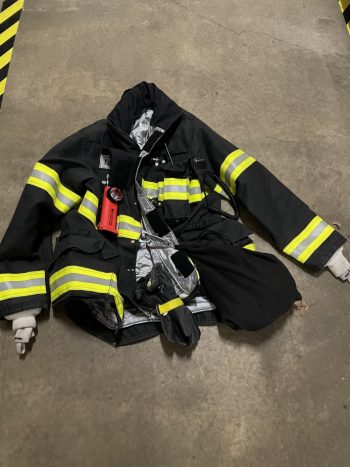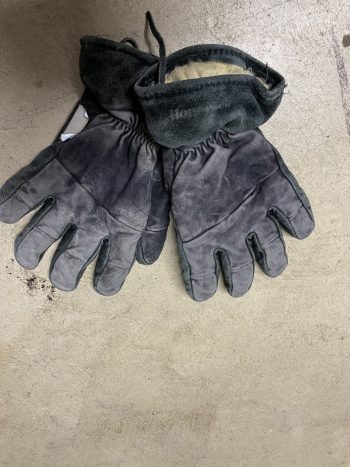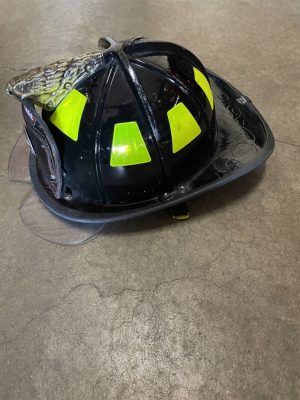Firefighters require the very best in clothing and equipment to allow them to enter fires and dangerous situations. The problem is that a lot of this gear can be pretty heavy. How much does this all weigh, why is firefighter gear so heavy, and can we make it any lighter?

The average weight of basic firefighter gear is around 45 pounds. This includes boots, pants, coat, gloves, hood and mask. However, the weight can vary greatly depending on what extra gear a firefighter decides to carry with them.
There is a lot to consider here for both the firefighters that have to wear all this equipment and the people designing it. This includes the following.
Table of Contents
What are the basic pieces of firefighting gear?
Let’s start with the basics.
All firefighters need to have some essential pieces of equipment on them to stay safe while battling fires and working in unsafe areas. You will see various names for this sort of kit. A lot of firefighters will call it “turnout gear” or “bunker gear.”
The following are the standard pieces of turnout gear include a coat, pants, boots, gloves, hood and SCBA (self contained breathing apparatus).
This is just the start, but it is the basic gear for heading into a fire. When you add the different pieces up in terms of weight, you are looking at around 45 pounds. This is a lot to carry around, especially when struggling in dangerous conditions.
Why is firefighter gear so heavy?
In many ways, firefighter gear has to be heavy to be effective. As you will see below, there are advancements and ideas to lighten the gear where possible.
But, there are limitations because of the type of protective gear needed. There are lots of tough and thick materials to keep wearers safe and also a lot of layers. Reduce the layers or remove a protective element and you run the risk of injury or worse.
Let’s start with the coat.
The firefighters turnout coat is large, thick, and highly protective. This is due to the use of three important layers.

The exterior is usually Nomex or Kevlar with a durable surface and fire-retardant properties. Then you get a water-repellent material to keep the skin dry, even if the jacket can get a little wet. This is essential to prevent burns if trapped water were to vaporize into steam.
Then there is an internal layer to protect wearers from the intense heat. All three are essential but add up to create something difficult to handle.
The helmet is just as important for protection against burns and heat. Thankfully, there aren’t the same heavy-duty leather helmets as there were in the past, as these would be even more difficult to wear for long periods.
Still, there is some weight to the plastic shell and you have to deal with flaps over the ears and neck. Again they are essential but add to the overall weight.
With the boots, firefighters need just as much protection and thermal insulation to protect their feet and legs.
Some may have leather for strength and waterproofing while others are insulated rubber. These heavy boots then have steel around the toes and shanks for better protection against injury, such as if part of a structure were to fall on their toes.
In some cases, you will also find gear with Gemtor loops and harnesses attached. These fixture points are great for creating a more practical piece of bunker gear as wearers can fix themselves to a ladder or have a point for being lifted to safety.
But, these extra features can add another 5lbs to the overall weight.
Finally, there is the all-important Self-Contained Breathing Apparatus. This is another necessity that makes it possible to breathe in smoke-filled areas, but the weight is significant.
Additional equipment carried by firefighters
It is also worth noting that this basic gear isn’t the only weight that firefighters need to contend with. There will be times where they need to carry equipment on their person to deal with the fires or other situations.
Some of these tools are pretty standard, such as a radio or a flashlight for communication and better lighting in a dark room. While relatively light on their own, they add weight in a pocket or clipped to gear.
I made a video on the FirefighterNOW YouTube channel going over all of the extra equipment I carry in my turnout gear while on duty. You can watch the video here:
Firefighters may also require special equipment in certain situations, such as a thermal imaging camera for locating survivors in structural collapse. The combination of extra tools could bring the total weight up to around 77 pounds.
Then there is the problem of wet gear.
Firefighter gear can get wet from the water used to extinguish a fire, if the sprinkler system in a building goes off, or if they are working on an incident in wet weather.
You will know from wearing a coat or pair of jeans in the rain how much heavier they can feel when wet. The same applies to any firefighter jackets that get drenched.
Why is all this heavy gear so dangerous for firefighters?
While there are definitely benefits to all these strong and protective layers, there are also dangers. The heavy weight of firefighter gear makes wearers work a lot harder and requires more effort to move.

Over time, this can make users tired and more breathless – which is no good in a smoke-filled building.
Regular use can put a lot of physical and mental stress on wearers. There are risks of fatigue and exhaustion that could not only put reduce the effectiveness of the team in an emergency but cause some firefighters to collapse.
This is why there is so much emphasis on physical fitness and training with firefighter gear when firefighters start out.
Is heavy firefighter gear dangerous?
The National Fire Protection Association publishes data on firefighter injuries and deaths with their attributed causes. The reading can be quite alarming when you look at the percentages.
The data from the report for 2019 details 48 firefighter deaths. The stats show that effective bunker gear can work really well as just 8% of fatalities were attributed to burns and there was 1 case of death from exposure to heat.
However, 54% of deaths are related to medical issues, stress, and/or overexertion.
It is unclear the extent to which the heavy gear contributed to these deaths.
But, it is significant that more than half of all deaths were of this nature rather than accidents on-site related to the fire, explosions, or structural collapse. 22 of those 26 deaths involved sudden cardiac death.
Improvements in firefighter gear
The good news for fire crews is that there are ongoing attempts to improve the situation and make firefighter gear lighter. The current weight and the health risks involved mean that even a couple of pounds here and there could make a difference.

It all comes down to being able to use lighter materials and perhaps fewer layers without compromising the protection against heat and flames.
There are companies with great advancements in firefighter gear materials. One called TenCate Protective Fabrics has a new option with a noticeable weight reduction.
The material is 5.6 ounces per square yard, while more common older options are around 7.5 ounces. This change should be incredibly noticeable over a larger jacket and the drop in weight could end up making life a lot easier for a firefighter.
The main thing that designers need to keep in mind is that the NFPA 1971 lays out an essential requirement they have to meet.
All PPE must protect users for a minimum of 17.5 seconds against heat penetration and decrease the risk of burns. There are concerns that a shift to lighter materials and new constructions could put this at risk.
Firefighter gear should become lighter in the future.
The current situation with the weight of firefighter gear isn’t ideal. There is so much weighing crew members down and putting them at risk.
But, each piece of kit is essential. Thankfully, advancements in designs and materials are resulting in improvements and we are sure to see better, lighter kits in the future.